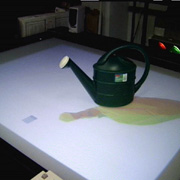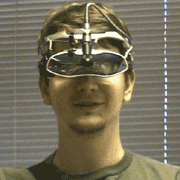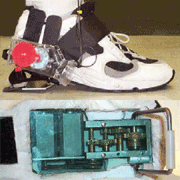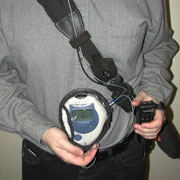- Face & Handwriting Recognition
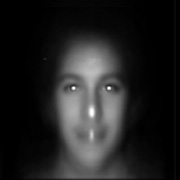
Eigenfaces

Wearable Face Recognition Interface
With obvious applications in security, face recognition has been a
focus for computer pattern recognition research for several decades.
The Eigenfaces technique uses principle component analysis to recover
vectors that more efficiently describe a training database of faces.
Given a new face image, the image can be projected on these vectors
and quickly compared to faces in the training database. This
comparison can be very efficient, allowing the comparison of thousands
of faces in a second. It can also be very compact with respect to
memory. In addition to some of the earliest and most extensive
experiments with Eigenfaces, we have investigated face recognition for
use in everyday applications on wearable computers.
Handwriting recognition is another traditional problem in pattern
recognition. We demonstrate how hidden Markov models (HMMs) can
achieve high accuracies (95-97% per word) in recognizing on-line
cursive handwriting of six subjects transcribing text with a 26,000
word lexicon and 86 symbols. Such a recognition system could be
adapted for use in a PDA or other tablet-based system. Having created
one of the earliest large databases of on-line script (now part of the
UNIPEN handwriting corpus), we also demonstrated how HMM recognition
accuracy can be improved through the use of context models and
statistical grammars in much the same manner as in speech recognition.
Publications & Related Projects
Symbiotic interfaces for wearable face recognition
(HCII, New Orlearns, LA, August 2001)  On-line Cursive Handwriting Recognition Using Speech Recognition Methods
(International Conference on Acoustics, Speech, and Signal Processing, April 1994)
On-line Cursive Handwriting Recognition Using Speech Recognition Methods
(International Conference on Acoustics, Speech, and Signal Processing, April 1994)  View-Based and Modular Eigenspaces for Face Recognition
(Computer Vision and Pattern Recognition Conference, Seattle, WA, July 1994)
View-Based and Modular Eigenspaces for Face Recognition
(Computer Vision and Pattern Recognition Conference, Seattle, WA, July 1994) 
Experiments with Eigenfaces
(Looking At PeopleWorkshop, IJCAI'93, Chamberry, France, August 1993)







